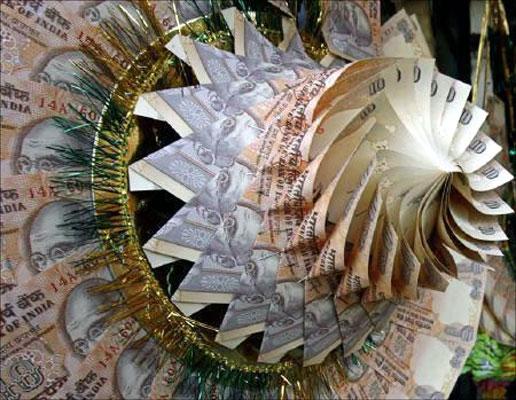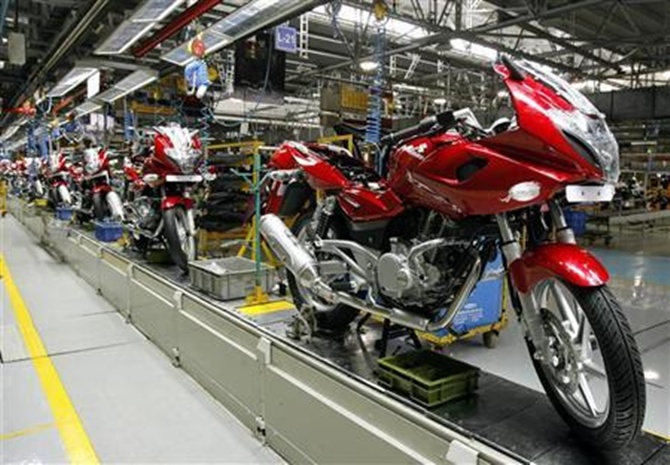 | « Back to article | Print this article |
India's self-created fiscal cliff
A closer look at deficit and accumulated debt suggests that, contrary to claims, the fiscal deficit is not under control, Rajiv Shastri says.
In recent months, the fiscal deficit has occupied centre stage in most macroeconomic discussions. While the government insists it’s under control despite indications to the contrary, markets wonder what magic it would take for that to be true.
Whichever side of the argument one chooses, the fiscal deficit is an important indicator of economic health, and no macroeconomic discussion is complete without it.
The fiscal deficit is typically expressed as a percentage of gross domestic product (GDP), primarily because this allows an intuitive understanding of its economic impact in general and its inflationary impact in particular.
Being an internationally accepted practice, this also allows for easy comparison across nations and regions. For example, we can immediately gather that India, with a combined (state and centre) fiscal deficit of 7.2 per cent of GDP in FY13, compares unfavourably with the European Union 27 (EU27) nation average of 3.9 per cent in 2012, but favourably with nations such as Ireland (8.1 per cent), Greece (9 per cent) and Spain (10.7 per cent).
Another economic parameter that flows naturally from such expression is the government’s debt-to-GDP ratio. This represents the total stock of debt acquired to finance the fiscal deficit through the years.
Click NEXT to read more...
India's self-created fiscal cliff
This is also an internationally comparable metric. Continuing with the above example, India, with a combined debt-to-GDP ratio of 66 per cent at the end of FY13, now compares favourably not only with the EU27 average of 85.2 per cent but also with Germany (81 per cent), which is normally considered a paragon of austerity.
Comparison with weaker EU nations such as Ireland (117.4 per cent) and Greece (156.9 per cent), then, seems pointless.
The impression derived from these comparisons is that India is a mildly profligate nation, but its debt-servicing ability is far better than most. However, this is accompanied by feelings of doubt.
If this is truly the case, shouldn’t India be rated much better than our current marginally investment grade rating? Aren’t we missing something?
In reality, quantifying deficit and accumulated debt only as a percentage of GDP has the potential to misguide. In isolation it distorts both, the true scale of fiscal profligacy and the government’s debt-servicing ability. Such distortion can be especially damaging since it diverts focus from potential crises.
Click NEXT to read more...
India's self-created fiscal cliff
For a clearer understanding, one needs to analyse deficit and accumulated debt differently. A simple, but effective, approach to ascertain over spending and debt-servicing ability is to compare both, deficit and accumulated debt, to annual revenues.
The resulting metrics also permit international comparison that helps in understanding our relative position as well.
The EU bloc is chosen as the comparative universe for fairly simple reasons. Apart from the ready availability of high-quality data, the 27-member bloc* includes nations of extremely varied economic health and evolution.
This allows for a wide comparative spectrum. Also, it can be safely assumed that these were at least as affected by recent crises as India, given that they were at the epicentre of some.
We begin by analysing combined government revenues-to-GDP to ascertain trends. From FY02 to FY13 combined government revenues average 20 per cent of GDP. They range from a high of 22.4 per cent in FY08 to a low of 18.1 per cent in FY02, but exhibit no clear trend.
Click NEXT to read more...
India's self-created fiscal cliff
In FY13, combined revenues amounted to 21.1 per cent of GDP. In comparison, the EU27 average for a similar time frame (calendar years 2001 to 2012) is more than double (44.4 per cent), hitting a high of 45.4 per cent in 2012.
Romania had the lowest average of 33.1 per cent, a good 65 per cent higher than India. In contrast to the earlier comparison, it now seems pointless to mention the highest (Norway - 56.8 per cent).
Circling back to the deficit, the scale of our problems is now increasingly apparent. With less than half the average revenues compared to the EU27, India’s average deficit over the period (7.5 per cent) is more than double that of the EU27 (3.3 per cent).
Crucially, governments of the EU27 spend 7.4 per cent more than they earn on average, with one extreme occupied by Norway spending 23.2 per cent less, and the other by crisis-ridden Greece that spends 19.8 per cent more.
In contrast, Indian central and state governments together spend a stunning 38 per cent more than they earn.
Moving on, accumulated debt (2012) for the EU27 amounts to 1.9 times 2012 revenues.
Click NEXT to read more...
India's self-created fiscal cliff
For India, it amounts to 3.1 times FY13 revenues at the end of the period, comparable only to Italy (2.7), Portugal (3), Ireland (3.4) and Greece (3.5). Even Spain, which is often shamed as a default possibility, compares favourably at 2.3 times 2012 revenues.
So, not only is it clear that the Indian governments (Centre and state) are almost recklessly profligate, it is also apparent that as a result of this profligacy, India’s fiscal condition can only be described as precarious. This leads to another question. Who is primarily responsible for this, the Centre or the states?
Popular narrative often assumes that state governments are reckless in their expenditure and it is their financial health that is precarious. Fortunately, with the available data, we can move beyond assumptions and investigate. A comparison of similar data sets, focusing only on central government finances, is startlingly revealing.
Central governments of the EU27 averaged revenues of 23.1 per cent of GDP from 2001 to 2012. The country with the lowest average is, surprisingly, Germany (12.6 per cent) and the highest, not surprisingly, Norway (48.5 per cent).
In contrast, the Indian central government averages revenues of 9.6 per cent of GDP from FY02 to FY13. By itself, a markedly small share of revenues for the central government isn’t worrying as can be seen from Germany’s numbers.
Analysing the deficit numbers, central government deficit for the EU27 averaged 2.9 per cent of GDP. While Norway generated a surplus of 13.9 per cent of GDP, Greece generated the lowest average deficit (8.8 per cent).
In comparison, the Indian central government generated an average deficit of 4.8 per cent of GDP. Again, the numbers seem relatively healthy in isolation.
But when seen in context, they are terrifying.
Click NEXT to read more...
India's self-created fiscal cliff
On average, central governments of the EU27 spend 12.8 per cent more than they earn with Norway at one end of the range, saving 28.5 per cent of its revenues. Greece (again) is at the other end spending 32.2 per cent more.
But the Indian central government outstrips all, spending a spectacular 51.3 per cent more than it earns on average! This phenomenal recklessness results in accumulated debt totalling 5.8 times FY13 revenues when compared to the EU27 average of 3.2 times. In corporate accounting equivalence, this means a leverage of 5.8 times annual sales.
Whether it’s the hubris from access to free money that drives this or a desire to subjugate states economically, the end result is just not fiscally justifiable. To make matters worse, the trend seems to be intensifying.
In the first seven months of FY14, the central government spent 99 per cent more than its revenues, compared to an average of 66 per cent for the previous five years. When will we fall off this precipice is a question only time can answer. But we are clearly not in control.
The author is Director & Business Head Portfolio Management Services & Product, Pramerica Asset Managers.
(These views are personal. *Croatia joined in 2009 to take the number to 28, but there isn’t enough historical data for the expanded group.)






